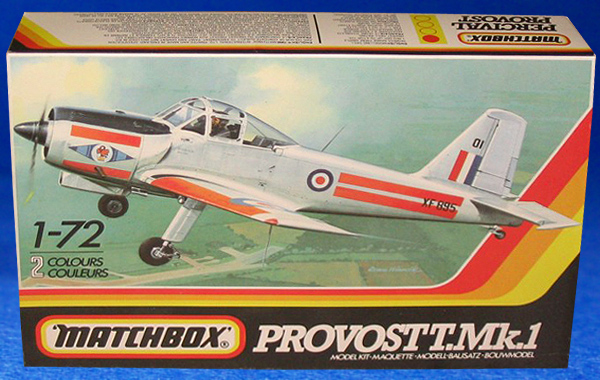 |

Kit: Matchbox #40030 |

Scale: 1/72 |
Value:
I purchased this kit for $3.00 (US) many years ago from a vendor at at IPMS show. Just about any kit is a good deal at that price. The kit has been out of production for decades but tons were produced so they still show up on eBay from time to time. |
Decals:
Decals are provided for tail code XF895 of RAF Central Flying School, and tail code XF688 of Sultan of Muscat and Omans Air Force. My decals were not printed well, details were "fuzzy" and the poorly registered roundels were all but useless. I ended up replacing nearly all decals with spares from other kits. |
Assembly:
The kit includes 31 parts molded in bright red and light gray, with 1 transparent cockpit canopy, one decal sheet and tri-fold black and white instruction sheet. Instructions are written in 5 languages with English being primary. Printed in color on the back of the box are top, bottom and side views providing indication for painting and decals.
Construction begins with a very sparse cockpit which consists of only a chair, two two pilots and a rollover bar. No control sticks are included nor any hint of any instrumentation. The single piece canopy is very thick with excessively wide framing so fortunately you can't see much of the interior anyway.
The fuselage and rudder are molded in left-right parts with the tail plane and wings molded in light gray. In traditional Matchbox fashion, the fuselage is molded in one color (red) with the wings molded in another (light gray) which is both annoying and nostalgically entertaining. Panel lines are raised and relatively crisp however there are not many to be found on this simplified kit. Fit is fair overall with filler required at the wing joints, around the engine cowling, and around the canopy.
The wheels and struts aren't especially good, but acceptable.
Although this kit is very toy-like, it can be built into a reasonably accurate replica of an important piece of RAF training history, and to my knowledge it is the only offering available. |
| After Market Parts Used: None |
Customizations:
Masking tape was used to create seat harnesses. Control sticks were used from other kits. Decals were replaced with spares. Brake lines were created with stretched sprue. Landing light was created from scrap parts, chrome sequin and clear epoxy. |
Recommendation:
This kit is ideal for beginners, but advanced modelers may also enjoy the challenge of creating a replica out of this very basic kit. Recommended for any fan of military basic trainers. |